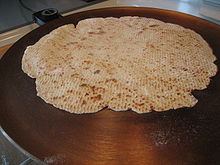| Griddle | |
|---|---|
 Lefse cooking on an electric griddle | |
| Classification | Cooking equipment |
| Industry | Various |
| Application | Cooking |
| Fuel source | Traditional fuels, natural gas, propane, electric |
A griddle, in the UK typically referred to simply as a frying pan or flat top, is a cooking device consisting mainly of a broad, usually flat cooking surface. Nowadays it can be either a movable metal pan- or plate-like utensil,[1] a flat heated cooking surface built into a stove or kitchen range,[2] or a compact cooking machine with its own heating system attached to an integrated griddle acting as a cooktop.[3]
A traditional griddle can either be a brick slab or tablet, or a flat or curved metal disc, while in industrialized countries a griddle is most commonly a flat metal plate.[citation needed] A griddle can have both residential and commercial applications, and can be heated directly or indirectly.[citation needed] The heating can be supplied either by a flame fuelled by wood, coal, or gas; or by electrical elements.[citation needed] Commercial griddles run on electricity, natural gas or propane.[4]
Griddles can be made of cast iron, but there are also non-stick varieties.[2] A residential griddle may be made of cast iron, aluminium, chrome steel, or carbon steel.[citation needed] The vast majority of commercial-grade griddles are made from A36 steel,[citation needed] though some are stainless steel or composites of stainless and aluminium.[citation needed] The plate surfaces of commercial griddles can be made of cast iron, polished steel, cold-rolled steel or can have a chrome finish.[4]
Etymology[edit]
The word griddle is attested in 13th-century English and it probably comes from Anglo-French gridil, which had developed over time from the Latin word craticula, 'small griddle' (craticula – graille – gredil – gridil),[1] possibly via the Latin craticulum, 'fine wickerwork'.[5]
Traditional and early modern[edit]

Traditional griddles include a stone or brick slab or tablet, and a shallow platter filled with sand. The former are usually heated to cooking temperature before the food is placed on them, the latter heated after.[citation needed] Later versions were sometimes integrated into the tops of wood-fired cookstoves as a removable iron plate, and later as a separate, typically handle-less plate covering one or more burners on a gas or electric stove.[citation needed]
Middle East[edit]

In traditional Middle Eastern and South Asian cuisines, a saj is a convex griddle that is used to cook a variety of flatbread types.
Latin America[edit]
In Latin America one traditional style of griddle is a budare. Made from stone or clay, it is used to cook a variety of flatbreads, such as tortilla, arepa and casabe. Modern versions for commercial use are metal and called comals.
Great Britain[edit]
In Britain the griddle is also called girdle, and is used for instance for making scones.[1] It can take the shape of a thick iron plate, round and held from above by a half-hoop handle.[1]
The traditional Scottish griddle (or girdle) has a flat wrought iron disk with an upturned rim to which a semicircular hoop handle is attached, allowing it to be suspended over the fire from a central chain and hook.[6] Girdles are used for cooking scones, bannocks, pancakes and oatcakes.[7][8]
The traditional Welsh bakestone is similar, circular with a one-piece handle, typically cast iron, 1 cm (0.4 in) in thickness. It is used to cook Welsh cakes, pikelets, and crepes.[9][10]
United States[edit]
In Upstate New York, a griddle used to be the lid covering a round opening on the cooking surface of a wood- or coal-burning stove.[1]
Commercial griddles[edit]
Dishes[edit]
Griddles are often used to prepare breakfast items such as pancakes, French toast, eggs and bacon, as well as stir-fries and meat dishes like hamburgers, steak and chicken breasts.[4]
Technical details[edit]
Commercial griddles can be 2–6 feet wide and 18–30 inches deep, and their plates can be flat or grooved.[4] The burners on the griddle units can be controlled manually or with the help of a thermostat.[4]
Gallery[edit]
-
A basic consumer electric griddle with temperature control
-
Griddle with ridged surface
-
Pancakes cooking on a commercial griddle
-
Catering griddle in a warship galley
See also[edit]
References[edit]
- ^ a b c d e Collins Dictionary griddle. Retrieved 23 December 2021.
- ^ a b "All About Griddles". The Spruce Eats. 12 December 2019. Retrieved 21 December 2021.
- ^ Vaculin, Kendra (12 March 2021). "The Best Griddles for Cooking Pancakes, Eggs, and Bacon (at the Same Time)". Epicurious. Condé Nast. Retrieved 23 December 2021.
- ^ a b c d e "A Guide to Grills & Griddles": general technical and construction details at the Foodservice Equipment & Supplies (FE&S) website. Accessed 23 Dec 2021.
- ^ "Griddle". Online Etymology Dictionary. Retrieved 1 November 2011.
- ^ "Griddle". TheFreeDictionary.com. Retrieved 17 October 2015.
griddle (ˈɡrɪdəl) n 1. (Cookery) Also called: girdle Brit a thick round iron plate with a half hoop handle over the top, for making scones, etc
- ^ "Archive - At Home on the Farm". NEFA - The North East Folklore Archive - Junior Section. Aberdeenshire Council. Retrieved 2 August 2011.
- ^ "Scran - Cooking oatcakes, or bannocks, on a girdle. Turnabrain, Glenesk, Angus, 1967". Retrieved 2 August 2011.
- ^ Barraud, Winifred K. (9 November 1962). "Bakestone tradition". The Guardian. London. p. 8.
- ^ "Welsh Bakestone Or Planc". Antique Kitchenalia. Archived from the original on 10 August 2015. Retrieved 9 November 2013.
External links[edit]
 Media related to Griddles at Wikimedia Commons
Media related to Griddles at Wikimedia Commons- Foodservice Equipment & Supplies (FE&S): the FE&S website has hundreds of pages on commercial griddles. Accessed 23 Dec 2021.
- "A Flash in the Pan": broad technical presentation of commercial griddles. Dan Bendall, 1 July 2006, Food Management, US. Accessed 23 Dec 2021.



